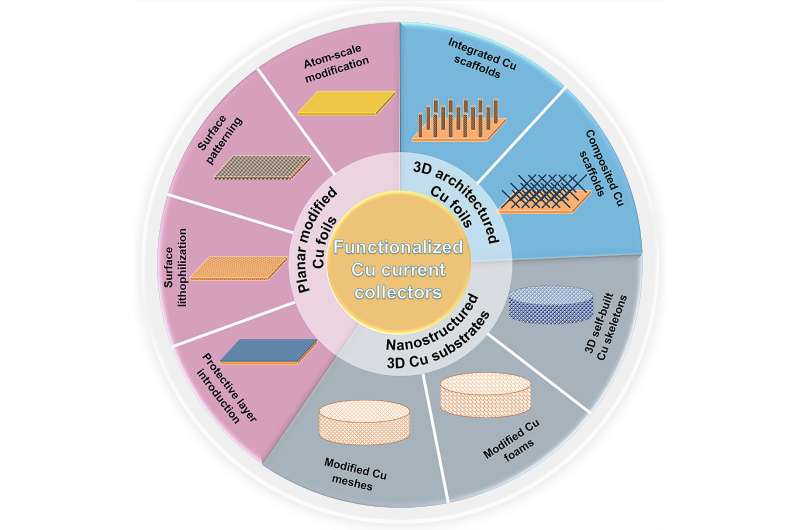Team completes review study of functionalized copper current collectors for lithium metal anodes

Lithium metal shows great promise as an anode material for next-generation high-energy-density batteries. However, the issues of dendrite growth and huge volume fluctuations that occur with lithium plating and stripping can result in fast capacity fading and safety concerns.
Because of these issues, the practical deployment of lithium metal anodes has not yet been achieved. Functionalized copper current collectors show potential for stabilizing the lithium metal anodes, along with providing easy fabrication, low cost, and good compatibility with existing battery technology. A team of researchers undertook a review study to provide a comprehensive overview of copper-based current collectors. Their work sheds light on the critical understanding of current collector engineering for high-energy-density lithium metal batteries.
Their review study is published in the journal Nano Research Energy.
The current collectors the team studied are the components that serve as a bridge between the lithium metal batteries and external circuits. They not only collect electrical current and transport it to the external circuits, but also support the deposition and dissolution of Li metal.
In their review, the research team focuses on the design principles and strategies of copper current collectors related to their functionalities in optimizing lithium plating and stripping behaviors. They also outline the critical issues that remain unsolved, along with future research directions.
“Functionalized copper current collectors exhibit great potential for stabilizing lithium metal anodes because of their facile fabrication and good electrical conductivity,” said Yuhang Liu from Northwestern Polytechnical University.
For the purpose of their study, the team divided the functionalized copper current collectors into three categories: 1) planar modified copper foils; 2) 3D architectured copper foils; and 3) nanostructured 3D copper substrates. They systematically summarized the design principles of the copper current collectors and the associate mechanistic insights into the lithium deposition behavior.
The team determined that the planar modified copper foils have achieved remarkably improved lithium plating and stripping processes. For the 3D architecture copper foils, the team concluded that these current collectors have made great progress for stabilizing lithium nucleation and deposition, especially under the conditions of high current density and cycling capacity. With the nanostructured 3D copper substrates, the team determined that the dendrite-free lithium metal anodes that have long-term stability and high-rate capability can be obtained.
With the development of functionalized copper current collectors, scientists have achieved significant improvements in the electrochemical performances of lithium metal anodes. Yet obstacles that need to be solved still exist, hindering the practical applications of lithium metal anodes. The research team points to several directions for future studies.
These suggested future studies include: 1) dynamic monitoring of the lithium plating and stripping process within copper-based current collectors; 2) evaluation of lithium plating and stripping behaviors under extreme conditions; 3) extension and exploration from the coin cells to pouch cells; and 4) anode-free lithium metal batteries based on the functionalized copper-based current collectors.
“To sum up, functionalized copper current collectors have exhibited high-efficiency in stabilizing lithium plating and stripping, which guarantees promising electrochemical performance of lithium metal batteries,” said Liu. In addition, because of their outstanding conductivity, robust structural stability and facile fabrication, the functionalized copper-based current collectors can also be extended to other energy-storage systems, such as lithium-ion batteries, sodium-ion or sodium metal batteries, or supercapacitors.
Looking ahead, the team hopes to achieve the practical applications of anode-free lithium metal batteries. “Our ultimate goal of developing functionalized copper-based current collectors is dendrite-free lithium growth, highly-reversible lithium plating and stripping, and ultralong cycling lifespan,” said Liu.
More information:
Yuhang Liu et al, Present and future of functionalized Cu current collectors for stabilizing lithium metal anodes, Nano Research Energy (2022). DOI: 10.26599/NRE.2023.9120048
Provided by
Tsinghua University Press
Citation:
Team completes review study of functionalized copper current collectors for lithium metal anodes (2023, January 17)
retrieved 17 January 2023
from https://techxplore.com/news/2023-01-team-functionalized-copper-current-collectors.html
This document is subject to copyright. Apart from any fair dealing for the purpose of private study or research, no
part may be reproduced without the written permission. The content is provided for information purposes only.
For all the latest Technology News Click Here
For the latest news and updates, follow us on Google News.
